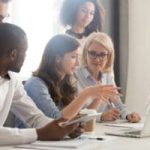
Millions of households are facing an increase in their council tax from April, as local authorities try to balance their books.
The County Councils Network (CCN) found three-quarters of English councils with social care duties that have published budget details are planning a 5% hike.
This is the maximum allowed without a local vote, and would add £100 a year to bills for average Band D properties.
The government said councils should consider money pressure on residents.
It said the amount local authorities will be able to spend next year was set to rise by £5.1bn, representing an average 9% rise for local authorities.
Work and Pension Secretary Mel Stride said the rise would be a “below inflation increase”. Consumer Prices Index (CPI) inflation rose by 10.5% in the 12 months to December.
The government had put “about £60bn worth of funding for the current year into local authorities,” Mr Stride added.
He said: “It is for local authorities who are elected by local electors to take those decisions to try and get that balance between the pressure they’re putting on local tax payers but also making sure they’re able to continue to provide those services.”
But council leaders say they have “little choice” but to raise tax in order to protect services, despite the rising cost of living for residents.
The CCN has analysed the budget plans of 114 out of the 152 councils in England with responsibility for social care that have published details so far.
It found 113 are planning to increase council tax, with 84 proposing a 5% rise from April and just one – Central Bedfordshire – keeping tax at its current rate.
The remaining 38 councils have yet to set out their plans. Three councils – Croydon, Thurrock and Slough – have special permission to increase tax above 5%, after effectively declaring bankruptcy.
Local authorities with social care duties will be able to raise council tax by up to 5% from April without consulting local residents, following an announcement at November’s autumn statement.
One authority planning to increase by the full amount, Hampshire County Council, said even with the hike it would still need to dip into its reserves to fill a financial deficit next year.
The average council tax for a Band D property in England for 2022/23 was £1,966. A 5% rise would add £98 a year to bills for an average property from April, although the amount will vary across England depending on location.
Some council leaders say the council tax system is unfair, as it raises different amounts in different parts of the country. It is currently subject to a review by Levelling Up Minister Lee Rowley.
Ministers say the amount available to councils next year is set to increase to almost £60bn, representing an average rise of 9.4%.
The Local Government Association, which represents more than 350 councils in England and Wales, says this figure assumes all councils will raise council tax by the maximum amount.
It has also expressed concern that a “significant proportion” of the increase is made up of one-off grants, ring-fenced funding, and some re-allocation of existing funding.
Sam Corcoran, the Labour leader of Cheshire East Council and CCN’s vice-chairman, said rising inflation and demand for social care services meant councils were setting their budgets in “the most difficult circumstances in decades”.
He added that despite pressures on residents, authorities had “little choice” but to put up council tax, with the alternative “drastic cuts to frontline services” given the financial pressures on councils.
The Levelling Up Department, which oversees council funding in England, said its increases to council funding would also see deprived areas getting more per household.
“Our approach to council tax balances the need to deliver vital services while protecting residents from excessive increases,” a spokesperson added.
“We expect local authorities to take into consideration the challenges many households are facing.”
Read more:
Millions facing 5% Council tax increases from April





